Would you rather have a healthy, restful sleep and wake up in a pool of water, or be disturbed by a menacing emergency alarm during your sweetest dreams?
If you are on board, you don’t really have a choice. Like it or not, emergency alarms are the number one priority to respond to, whatever seemingly important things you are doing.
They warn us that something bad is happening, and we should do something about it before it does something to us.
However, not all alarms on ships are signs of extreme danger.
You do not have to panic and put on your life jacket every time you hear or see a ringing, buzzing, beeping, whistling, blasting, or flashing signal.
The ones that you should be very aware of are those listed in the vessel’s book of emergencies.
What are emergency alarm signals on ships?
A ship’s emergency alarm signals are audio-visual warning systems that specifically indicate the occurrence of a particular danger.
They are very different from non-emergency signals like those on the bridge, the cargo, or the engine room since they are more localized and only require the attention of a particular person.
Emergency alarms are more intense! You can hear it everywhere on board because it requires the participation of all the crew and passengers if any.
In the engine room where it is very noisy, these types of alarms are paired with a visual appliance like the flashing of a strobe light.
Moreover, such alarms prompt a very important message that should be acted upon immediately. Not doing so may result in the loss of life, of the ship, or even both.
Examples are fire alarms, oil spill alarms, man overboard alarms, abandon ship alarms, CO2 release alarms, security alarms, and general emergency alarms.
We will discuss them in more detail below.
1. Fire Alarm on Ships
A fire alarm indicates that a part of the ship is on fire or that the fire is just starting out. Even the presence of smoke triggers this type of alarm.
Fire alarms use sensors installed all over the vessel to monitor the presence of fire. It can be activated manually or automatically.
Here are the methods for triggering fire alarms on board.
- Smoke detectors
- Heat detectors
- Fire detectors
- Using manual call points
- Main emergency alarm panels
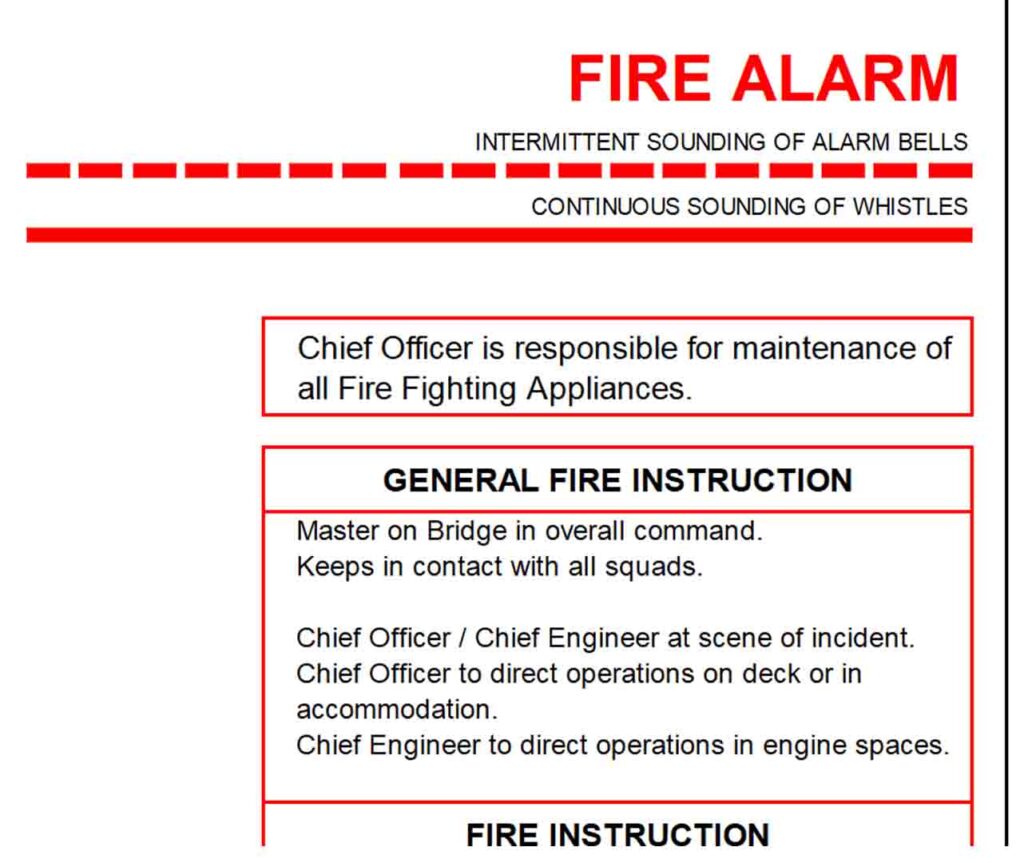
Sometimes, alarm sensors fail to trigger even if there is already smoke or fire.
I had a crewmate who was banging on the alleyways while shouting “FIRE! FIRE! FIRE!” as he proceeded aft to extinguish it.
Interestingly, it was a fire in the ship’s swimming pool. The alarm sounded after firefighting and got under control.
You can easily distinguish a fire alarm signal. When activated, you will hear an intermittent sounding of the alarm bells coupled with a continuous sounding of whistles.
Some fire alarms have a continuous sounding of the general alarm accompanied by four prolonged blasts on the whistle.
Again, always check your emergency plan or station bills to know which fire alarm signals your vessel is using.
2. Abandon Ship Alarm
When the vessel is no longer safe to stay due to an uncontrollable fire or sinking, the captain raises the abandon ship alarm.
An abandon ship alarm indicates that all crew members must abandon the vessel by proceeding to the lifeboat stations.
They must bring with them their lifejackets, immersion suits, extra food and water, blankets, and other things needed to survive while awaiting rescue.
It is one of the most terrifying signals you will hear on board, especially if it happens during a very rough sea.
An abandon ship alarm signal consists of seven short blasts followed by one prolonged blast on the ship’s whistle.
On some vessels, it is accompanied by the continuous sounding of the alarm bells.
A verbal announcement from the captain to abandon the ship follows on the public address system.
You must make sure that the verbal command is given before abandoning the vessel, as false alarms may happen.
This is by far, the most widely used pattern for signaling an abandon ship. But again, you must double-check your vessel.
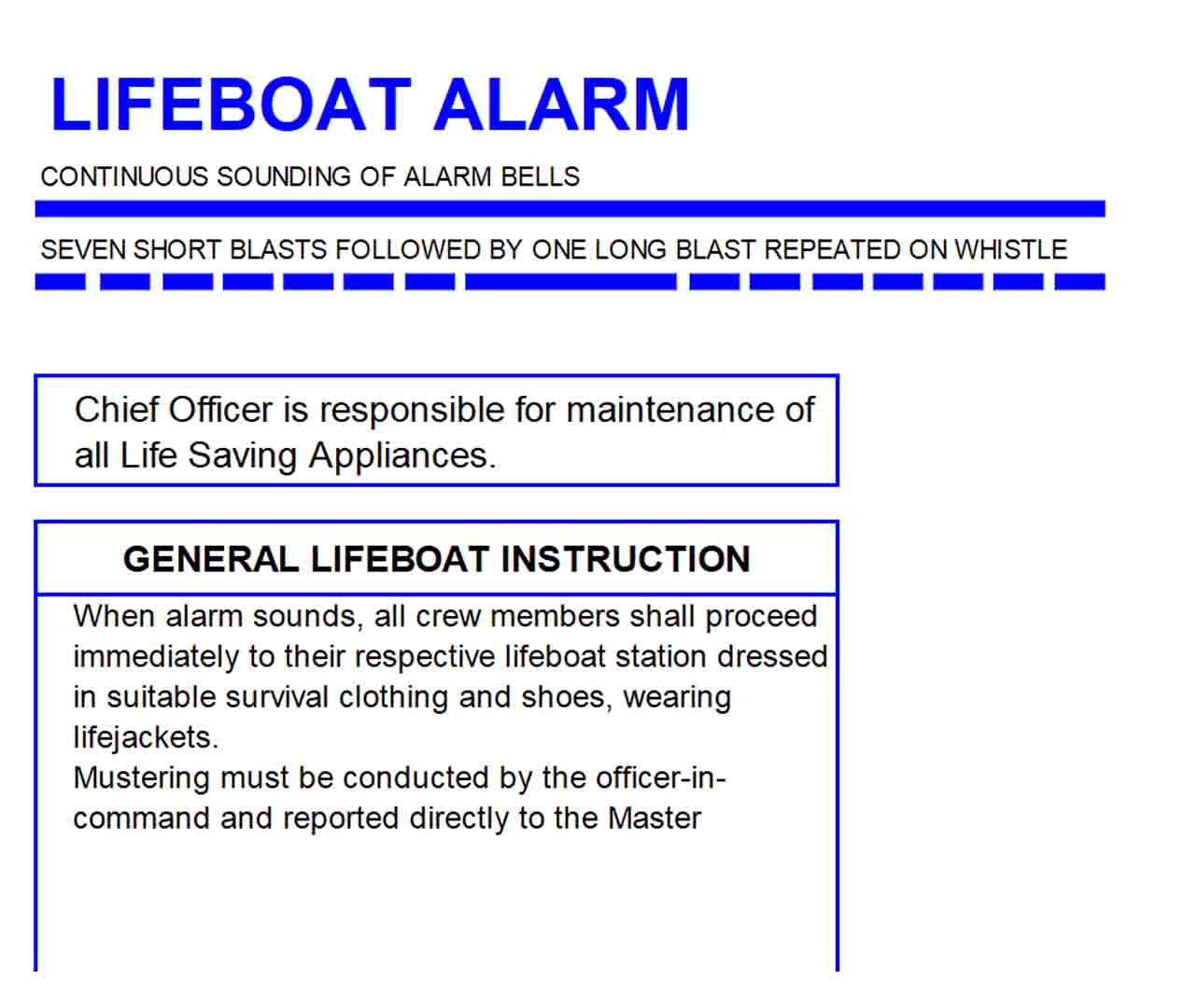
3. Man Overboard Alarm
That man overboard alarm is the most recognizable alarm, not because I experienced it firsthand, but because it is adopted from the Morse signal “Oscar” or the letter “O.”
When a person falls in the water, whether at sea while the ship is underway, in port when she is at anchor, or on a jetty where she is berthed, she must sound the man overboard alarm.
The ship then maneuvers depending on the situation, while a lifebuoy with a light and smoke signal is thrown on the water to mark the MOB position.
To recover the man overboard, the crew gathers the rescue team and launches the rescue boat onto the water.
A man overboard alarm sound consists of three prolonged blasts on the ship’s whistle. This is the morse signal for the letter “Oscar.”
Aside from the crew hearing the signal, it also warns other vessels in the vicinity.
On some vessels, the alarm signal for a man overboard is the same as the general emergency alarm. We will discuss them below.

4. CO2 Release Alarm
CO2, or carbon dioxide, is a fixed fire-extinguishing agent that is widely used on board. \
This gas suffocates the fire by depleting its oxygen. This also means that it can asphyxiate anyone in the room when this gas is released.
So before releasing the CO2, the captain first raises the CO2 alarm to warn the crew that this gas will be used.
They will also close all openings to keep the gas contained in the burning space.
Lastly, the whole crew conducts a head count to ensure that nobody is missing. Only then can the master or chief engineer release this gas.
A CO2 release alarm is very recognizable from other alarm signals. It consists of an audio-visual warning signal. The sound signal is a continuous blasting of the CO2 horn inside the protected space.
The CO2 horn’s sound is very high-pitched compared to other alarm signals. It is coupled with high-intensity strobe lighting to make it more noticeable in case the room is very noisy.
Here is an example of a CO2 alarm in the engine room. Notice that the CO2 indicator also lights up, emphasizing what the signal is all about.
5. Ship’s security alarm
Also known as a ship’s security alarm system (SSAS), this type of alarm triggers when there is a security threat on board the vessel.
This alarm signal is a requirement of the SOLAS Convention under the ISPS and ship security chapter.
The rise of piracy attacks on vessels sailing through pirate-infested areas like Somalia, the Gulf of Aden, or West Africa made this signal very useful.
When activated, the SSAS sends an alarm to the shipowners on shore and the flag states. They will alert the local authorities where the vessel is located so appropriate measures can be taken.
Meanwhile, the ship does not exhibit any audio-visual alarm.
The activation points of the SSAS are well hidden and only known by the Master and the Ship Security Officer.
When the shipowner calls the vessel to verify the alarm, they will use coded messages to determine if the signal is legit or only a false alarm.
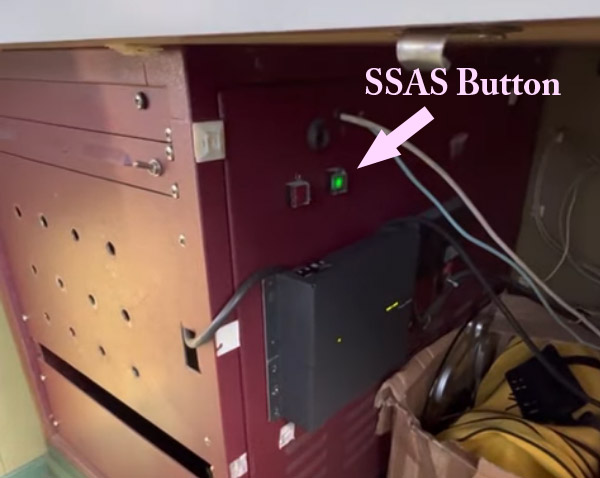
6. General Alarm
A general alarm is an emergency signal of seven short blasts followed by one prolonged blast on the ship’s alarm bells and whistle. It informs the ship’s crew that there is an emergency happening on board including those listed above.
But since the above emergencies already have specific alarms assigned to them, the general alarm is used for other types like those listed here.
- Oil Spill
- Emergency steering
- Toxic gas release
- Helicopter emergency
- Grounding/ Stranding
- Collision
- Flooding
- Excessive list
- Serious illness, injuries, or death.
- and many others
Imagine memorizing distinct alarms from those emergencies. That would be mind-boggling.
To avoid confusion, many ships use general emergency alarm signals.
A general emergency alarm normally consists of seven short blasts followed by one prolonged blast on the ship’s whistle.
The ship’s bell also sounds the same signal using the same pattern as the whistle. This is to ensure that the alarm is delivered successfully in case the bell or whistle fails.
After that, the captain announces the particular emergency using the public address system (PA system).
Every general alarm must be followed by an announcement over the public address system.
If you’ve noticed already, the signal for the fire alarm and the general emergency alarm is the same. The only determining factor is the declaration in the PA System.
Thus, the general alarm signal can be used for all emergencies on board, and you won’t be lost as long as you pay attention to the public address.
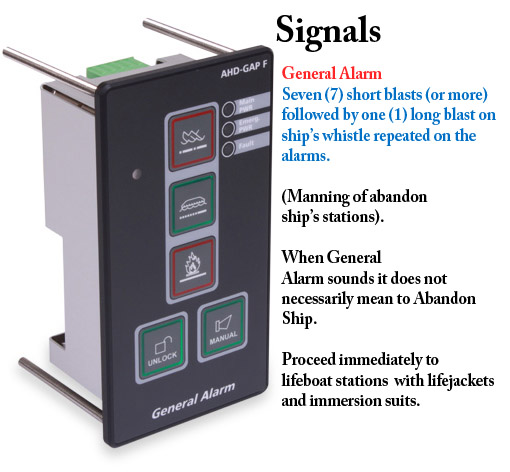
Why is it important to know these alarms?
Since all vessels are prone to emergencies, you will most likely encounter any of those alarms on board.
But these signals differ from one company (or one ship) to another. It is your job as a seafarer to memorize them so you can respond accurately.
Actually, there is no excuse not to know them. Part of our training onshore includes emergency preparedness.
We are bombarded with drills and onboard familiarizations every month. We even have computer-based training as a cherry on top.
Vetting inspectors, port state control officers, coast guards, and other authorities may ask you about this. And you do know the consequences if you fail.
But I think the most important reason for knowing these alarms is that it builds focus and confidence.
When you hear them and do not know what kind of emergency it signifies, your actions become uncertain. It makes you fearful and confused while trying to figure out what’s happening.
However, if you hear an alarm signal and immediately realize the emergency behind it, you will immediately know what to do.
Your actions will have clarity and focus. These mindsets are very important in times of danger.
To avoid beating yourself in regret, ensure that you are well-versed with the alarms.
What if you ignore the emergency alarms?
Two words.
Big mistake.
Alarms are there to warn us that our ships and the lives in her are in grave danger. Ignoring them means suicide.
You can choose to ignore them, but what about your crewmates?
If out of 25 crew members, one refuses to answer the call for emergency, the other 24 will assume that you are injured (or dead) and will start a search and rescue within the ship.
And if they can’t find you, there is nothing they can do but continue to respond to the emergency.
If the crew saves the ship and mitigates the emergency, I’m sure that your retardation will not have any place on board.
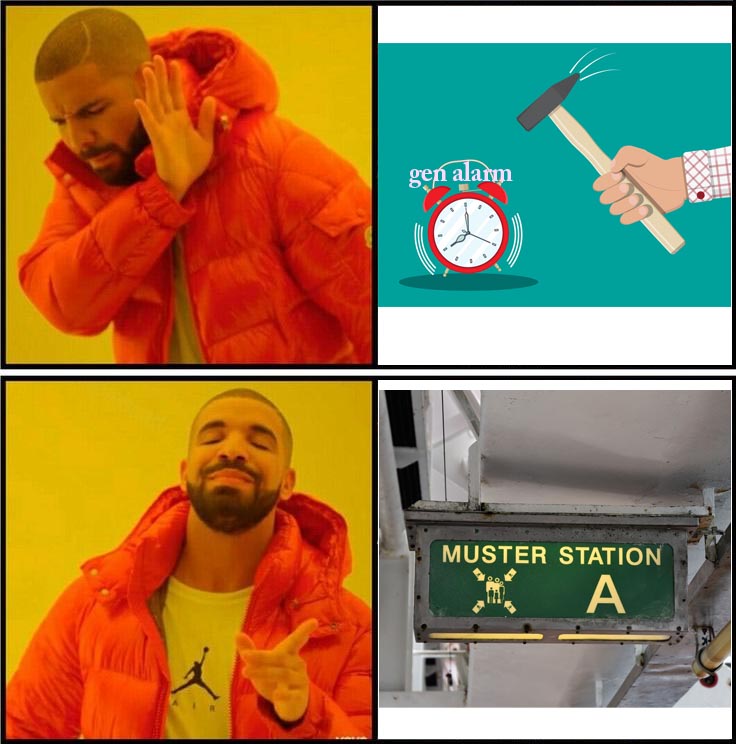
Tips on how to easily memorize these emergency alarm signals
The best way to memorize these signals is to pay attention when the alarm sounds especially during safety drills.
And I do have semantics to quickly recall them. First, let’s go to the easy ones.
The alarm signal for a man overboard is the Morse Code “Oscar,” which is three long dashes (— — —).
Now as a seaman, you must memorize the signal for distress, which is SOS or • • • — — — • • •.
As a reference, Nokia’s phone ringtone for SMS, which is (• • • — — • • •), is one letter (or dash) close to SOS which is • • • — — — • • •.
Here’s Nokia’s SMS ringtone.
Fire alarms are intermittent which means they go on and off in rapid, continuous succession. That’s why it is (in-ter-mit-tent).
General alarms and abandon ship alarms are mostly the same except for the PA announcement.
However, they might be a little confusing in the first round. As long as you hear a prolonged blast, even if you are confused about counting the short blasts, consider it a general alarm.
Who knows, you could be very nervous while counting, thus getting lost in the numbers.
CO2 alarms in engine rooms, pump rooms, or other protected spaces are coupled with an audio-visual tone. Its sound signal is continuous but with a very high pitch.
Lastly, you don’t need to worry about the SSAS or security alarm, since you won’t even know when someone has already activated it.
Final thoughts
Imagine if alarms were not invented.
Many ships and crew members on board would die without putting up a fight against real emergencies. They would not know what hit them!
We should be thankful that these alarms function even if it’s the dead of the night. And we should be more grateful not to use them in the first place.
May the winds be in your favor.

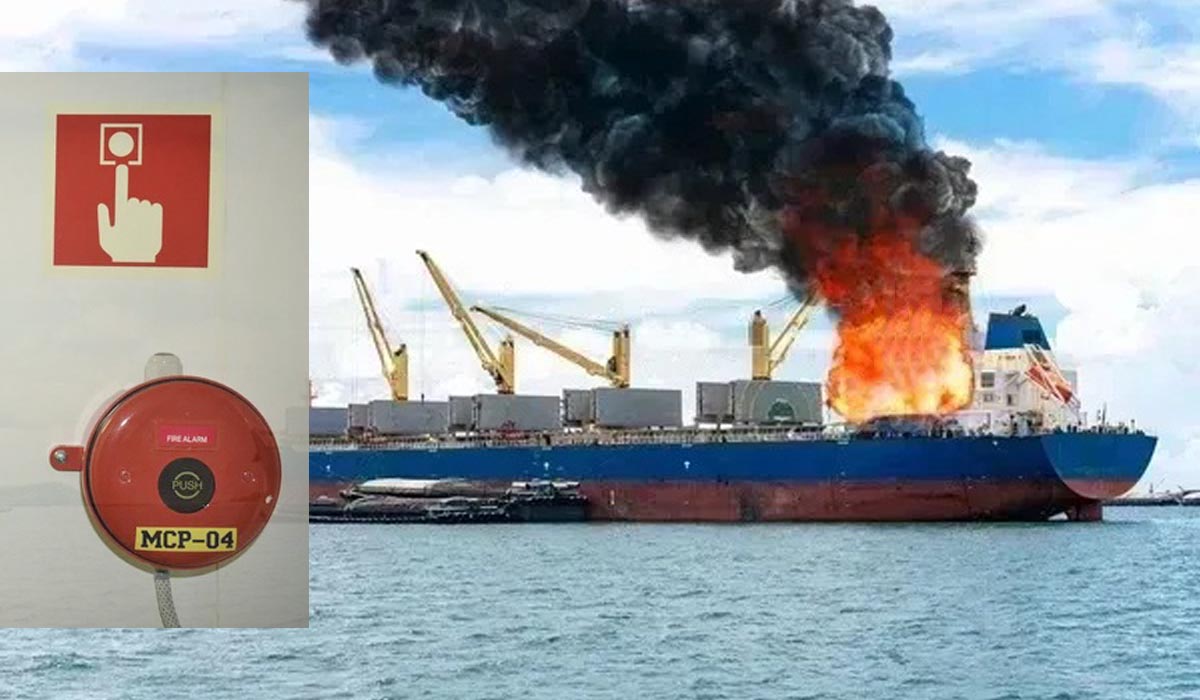
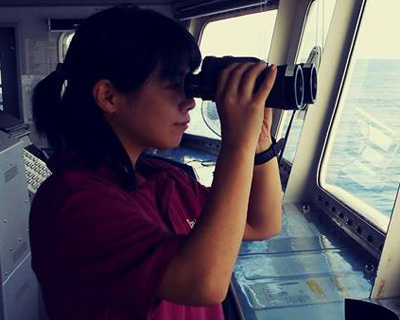
0 Comments